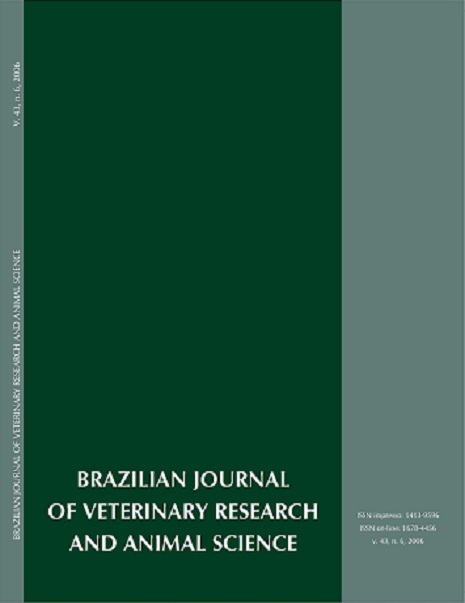Estrous characterization in cross-bred heifers (Bos taurus indicus x Bos taurus taurus) by radiotelemetry
DOI:
https://doi.org/10.11606/issn.1678-4456.bjvras.2006.26562Keywords:
Estrous, Radiotelemetry, Heat-WatchAbstract
Although artificial insemination (AI) has countless advantages, in Brazil this technique is performed in only 7% of beef cattle. Failures on estrous detection are the main limiting factor to the success of this technique. An electronical system, based on radiotelemetry, was developed for estrous detection. This system provides day, hour and service length. The present study aimed to evaluate by radiotelemetry system the behavioral characteristics of the estrous of crossbred heifers (Bos taurus taurus x Bos taurus indicus) raised at pasture regimen in southwest region of Brazil. The hypothesis is that estrous lenght and service frequency are variable among females and that most of services occur at nocturnal period. For estrous synchronization, heifers received 0,5mg of MGA/animal/day, once a day during 8 days, and 15mg of luprostiol (PG), IM, at the last day of MGA treatment. Estrous were registered in a radiotelemetry system, denominated “Heat-Watch”, during a 120 hours period after PG injection. The mean of estrous length was 10,4 + 5,7 hours (ranging from 45 minutes to 22,7 hours). The mean of number of services was 26,2 + 13,6 (ranging from 3 to 81 services). The mean of services length was 2,7 + 0,3 seconds. Dransfield et al.4 classified the estrous in short (< 7 hours) and long (>; 7 hours) length and low (< 1,5 services/hour) and high (>; 1,5 services/hour) intensity. There was a higher incidence of long length when compared to short lenght (72,8% vs. 27,2%; P<0,05) and higher incidence of high intensity estrous when compared to that of low intensity (70,2% vs. 29,8%; P<0,05). The mean of services at day period (7:00 AM to 7:00 PM) was 10,0 + 9,7 and at night period was 13,0 + 12,4 (7:00 PM to 7:00 AM). Effect of period on services number was not observed (P=0,08). In the present study it was confirmed the hypothesis that estrous behavior is extremely variable among females, however, the hypothesis that most services occur at night period was not confirmed.Downloads
Download data is not yet available.
Downloads
Published
2006-12-01
Issue
Section
UNDEFINIED
License
The journal content is authorized under the Creative Commons BY-NC-SA license (summary of the license: https://
How to Cite
1.
Bertan CM, Binelli M, Madureira EH. Estrous characterization in cross-bred heifers (Bos taurus indicus x Bos taurus taurus) by radiotelemetry. Braz. J. Vet. Res. Anim. Sci. [Internet]. 2006 Dec. 1 [cited 2025 Dec. 30];43(6):816-23. Available from: https://revistas.usp.br/bjvras/article/view/26562





